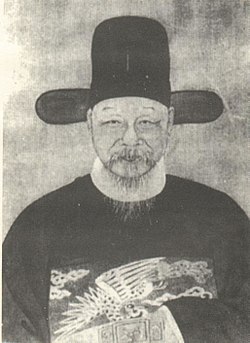Gu Xiancheng

Gu Xiancheng(Chinese:Cố hiến thành;pinyin:Gù Xiànchéng;1550–1612) was aMing dynastyChinese bureaucrat and educator who founded theDonglin movement.
He was born inJiangnan,to a mercantile family, and from an early age was tutored in theChinese classics.He quickly rejected theYaojiang schoolofWang Yangming,favouring the strong moral dichotomy of earlierSongphilosophers such asZhu Xi.[1]A student ofXue Yingqi,[2]he held office as Grand Secretary in the Imperial Court.[3]
Together with his brother and his student Gao Panlong he rebuilt theDonglin ( "East Forest" ) Academyin 1604, in the town ofWuxi.[4]
The Donglin Charter was based on Zhu Xi'sArticles of the White Deer Grotto,and incorporated quotations from a number of Confucian classics. Gu required prospective entrants to have four key qualities, which he called the Four Essentials: students had to consider their fundamental nature, show firm resolve, respect the Classics and scrutinise their own motivation.[5]
Gu's Academy quickly attracted a large student base, and became a rallying point for dissent and criticism of the government, in the form of theDonglin movement.The Academy was strongly critical of the notorious eunuchWei Zhongxian,and as a result of Wei's persecution it was shut down in 1622; it reopened some years later after the eunuch's death.[3]
References
[edit]- ^Frederic E. Wakeman, Jr. (2009).Telling Chinese History: A Selection of Essays.University of California Press. pp. 146–.ISBN978-0-520-25606-4.Retrieved7 June2013.
- ^Struve, Lynn (2008),"Ancestor Édité in Republican China The Shuffled Journal of Xue Cai"(PDF),The East Asian Library Journal,13(1): 33–65,retrieved7 June2013
- ^abGu, Xiancheng (1573)."Random Notes from the Xiaoxin Pavilion".World Digital Library(in Chinese).Retrieved7 June2013.
- ^"Donglin".Encyclopædia Britannica.Retrieved7 June2013.
- ^William Theodore De Bary (2008).Sources of East Asian Tradition: Vol. 1 Permodern Asia.Columbia University Press. pp. 465–467.ISBN978-0-231-14305-9.Retrieved7 June2013.
